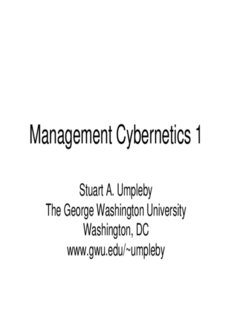
Slides used in the Tutorial - International Institute of Informatics and PDF
Preview Slides used in the Tutorial - International Institute of Informatics and
Management Cybernetics 1 Stuart A. Umpleby The George Washington University Washington, DC www.gwu.edu/~umpleby Perspectives on Management • Professional approaches: finance, accounting, marketing, personnel admin. • Disciplinary approaches: organizational behavior, operations research, decision analysis, information systems • Type of organization: small business, international business, public administration Management Cybernetics • Is an interdisciplinary approach • Addresses organizations of any size or type • Focuses on the organization as a whole rather than a part • Emphasizes cognitive processes: information processing and decision making, learning, adaptation What will be discussed • Edwards Deming – process improvement methods • Stafford Beer – the Viable System Model • Russell Ackoff – Interactive Planning • Forrester and Senge – system dynamics • Elliott Jaques – the quintave theory • Gerard Endenburg -- sociocracy Themes in the tutorial • There are MANY ways to think about the management of organizations • Only a few attempt to take a holistic perspective • But there are great differences even among the holistic views • Can each of these views be “right” About management consulting • Usually a management consultant is hired for his technical expertise • But success depends more on emotional skill • Often there is an underlying problem that is creating the perceived problem • What are emotional or political reasons why the underlying problem is not addressed? Underlying themes • Complexity is defined by the observer • Using any analytic method is better than using no analytic method • The reason is the law of requisite variety and the “magical number seven plus or minus two” Process improvement methods • Are the most significant contribution to management thought in the last half of the 20th century • Have had a dramatic effect on the relative competitiveness of nations • Embody Ross Ashby’s theory of adaptive behavior The most famous name in Japanese quality control is American His name is Dr. W. Edwards Deming, and he’s a quality control expert. In 1950, the Union of Japanese Scientists and Engineers (JUSE) invited Dr. Deming to lecture several times in Japan, events that turned out to be overwhelmingly successful. To commemorate Dr. Deming’s visit and to further Japan’s development of quality control, JUSE shortly thereafter established the Deming Prizes, to be presented each year to the Japanese companies with the most outstanding achievements in quality control. Today, Dr. Deming’s name is well known within Japan’s industrial community, and companies compete fiercely to win the prestigious Demings. In 1953, Sumitomo Metals was fortunate enough to win the Deming Prize For Application. In retrospect, we believe it may have been the single most important event in the history of quality control at Sumitomo. By inspiring us to even greater efforts, it helped us to eventually become one of the world’s largest and most advanced steel-makers. Sumitomo Metals owes a great deal to the American quality control expert who became one of Japan’s greatest inspirations. On that point, the management and employees of Sumitomo metals would like to take this opportunity to say simply, “Thanks, Dr. Deming, for helping to start it all.” THE DEMING FLOW DIAGRAM Consumer Design and research redesign Suppliers of materials and Receipt and test of Consumers equipment materials A Production, assembly, inspection B C D Tests of processes, machines, methods, costs
Description: